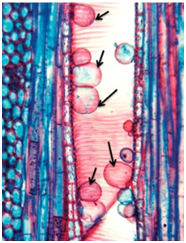In the transverse section of a monocot root given below, identify A, B, C and D:

A
B
C
D
1.
Epidermis
Exodermis
Endodermis
Pericycle
2.
Exodermis
Epidermis
Endodermis
Pericycle
3.
Epidermis
Exodermis
Pericyle
Endodermis
4.
Exodermis
Epidermis
Pericyle
Endodermis

Identify the correct statement regarding A and B [types of concentric vascular bundles] in the given diagram:
1. A is Amphivasal and found in Dracaena while B is amphicribal and found in Selaginella
2. A is Amphivasal and found in Selaginella while B is amphicribal and found in Dracaena
3. A is Amphicribal and found in Dracaena while B is amphivasal and found in Selaginella
4. A is Amphicribal and found in Selaginella while B is amphivasal and found in Dracaena
Identify the option where the difference between the vascular bundles of Dicot and Monocot stem is not correctly mentioned:
|
|
Dicot stem |
Monocot stem |
|
1. |
Collateral and open |
Collateral and closed |
|
2. |
Arranged in a ring |
Scattered |
|
3. |
Larger toward the center |
Of uniform size |
|
4. |
Phloem parenchyma present |
Phloem parenchyma absent |
Identify the option where the difference between the anantomy of Dicot and Monocot root is not correctly mentioned:
|
Dicot root |
Monocot root |
||
|
1. |
Xylem bundles |
Numerous |
Vary between 2 and 6 |
|
2. |
Pith |
Small/absent |
Large/well developed |
|
3. |
Pericycle |
Gives rise to lateral roots, cambium and cork cambium |
Gives rise to lateral roots only |
|
4. |
Cambium |
Appears later as a secondary meristem |
Altogether absent |
In the given diagram:
1. the lighter outer area is the heart wood or alburnum and is mechanically strong, resistant to decay, and less easily penetrated by wood-preservative chemicals
2. the lighter outer area is the Sapwood or alburnum and is involved in transport of water and minerals to the crown of the tree
3. the darker inner area is the heart wood or duramen and is involved in transport of water and minerals to the crown of the tree
4. the darker inner area is the sap wood or duramen and is mechanically strong, resistant to decay, and less easily penetrated by wood-preservative chemicals
The following diagram shows the anatomy of the root of an epiphytic orchid. The function of the structure marked X is:
1. Photosynthesis
2. Storage
3. Protective
4. Repair and healing
The balloon like structures seen in vessels in the given diagram are called as:

1. Tyloses
2. Hydathodes
3. P proteins
4. Lenticells
In the given diagram showing the anatomy of a tree trunk, what are A, B, C and D respectively?
1. Secondary xylem, Secondary phloem, Periderm, Bark
2. Secondary phloem, Secondary xylem, Periderm, Bark
3. Secondary xylem, Secondary phloem, Phellem, Periderm
4. Secondary phloem, Secondary xylem, Phellem, Periderm
In the section of a monocot leaf shown in the given diagram, what would be true for the structures labeled X?
1. They regulate the opening and closing of the stomata in the adaxial surface of the leaves
2. Due to presence of lignin in their walls they provide support to the leaf surface in windy conditions
3. They are involved in folding and unfolding of leaf tissue to control light intensity and reduce overall water loss
4. They are abnormal cells produced during healing of the adaxial surface after injury and are common portals of entry of viruses into the plants
In the given diagram if xylem is represented by 1, the companion cells will be represented by:
1. 2
2. 3
3. 4
4. 5












